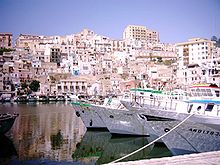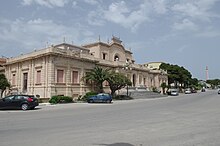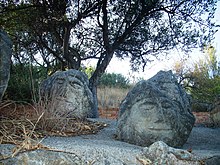Sciacca
| Sciacca | ||
|---|---|---|

|
|
|
| Country | Italy | |
| region | Sicily | |
| Free community consortium | Agrigento (AG) | |
| Local name | Sciacca | |
| Coordinates | 37 ° 31 ' N , 13 ° 5' E | |
| height | 60 m slm | |
| surface | 190.98 km² | |
| Residents | 40,068 (Dec. 31, 2019) | |
| Population density | 210 inhabitants / km² | |
| Post Code | 92019 | |
| prefix | 0925 | |
| ISTAT number | 084041 | |
| Popular name | Saccensi, Sciacchitani | |
| Patron saint | Maria SS. Del Soccorso | |
| Website | Sciacca | |
Sciacca [ʃakka] is a port city and a thermal spa in the Mediterranean in the consortium of municipalities Agrigento outdoors in the region Sicily in Italy .
Location and dates
The port city of Sciacca is about 50 kilometers northwest of Agrigento . The city has 40,068 inhabitants (as of December 31, 2019) who are employed in industry, agriculture and tourism (including thermal baths ).
Sciacca, together with the municipalities of Menfi , Sambuca di Sicilia and Santa Margherita di Belice, forms one of the most important wine-growing regions in Sicily. Since 1998 there has been a controlled designation of origin for quality wine ( Denominazione di origine controllata ) for the municipality's vineyards with the "DOC Sciacca" .
The neighboring municipalities are Caltabellotta , Menfi, Ribera and Sambuca di Sicilia.
After the rail traffic to Sciacca was discontinued in 1985, the place can only be reached by road (or by sea) today.
history
In the east of the city are the remains of a Sican settlement, called Figuli settlement, which documents an already prehistoric settlement of the area around Sciacca. The find of the Bronze Age statuette of Melqart of Sciacca is significant . The Romans already knew the healing springs.
The city grew under the rule of the Arabs and Normans. The current structure of the old town was created under the Arabs. The city wall and the fort were also built at this time. The name of the city comes from Arabic ( Arabic الشقا Al Shaqqah , DMG aš-Šaqqā ).
In 1330 the city walls and the fort were renewed under Frederick II of Aragon . New churches and monasteries were built in the 16th century. After this period, as a result of the feud (Caso di Sciacca) between the Perollo family and the Counts of Luna, which lasted almost 70 years, the city fell into disrepair.
During the Second World War there was a strategically important military airfield near Sciacca ( ⊙ ), which was also called aeroporto fantasma because of its very good camouflage .
After the Second World War, today's thermal facilities were built.
Viticulture
Since 1998 there has been a denomination for quality wines called "Sciacca DOC", which was last updated in 2014. Both white and red blended wines as well as almost single-variety wines are produced. If the grape variety is mentioned on the label , it must contain at least 85%. There is a sub-zone (sottozona) called "Rayana".
Culture
Along with Acireale and Termini Imerese, Sciacca is one of the carnival strongholds of Sicily.
Buildings
- Thermal baths on Monte Kronio and Via Agatocle
- Castello dei conti Luna
- Chiesa di Maria SS. Del Soccorso, cathedral built in the 12th century (facade from the 16th century)
- Piazza Scandaliato, center of the city with the 17th century town hall
- Castello Incantato , sculpture garden
Surroundings
- The Monte San Calogero or Monte Kronio is located in the east of the city and is the highest point in the city. On top of it is the unfinished Hotel Grande San Calogero .
Town twinning
-
 Salvador da Bahia , Brazil, since 2001
Salvador da Bahia , Brazil, since 2001 -
 Aprilia , Italy, since 2003
Aprilia , Italy, since 2003 -
 Kırşehir , Turkey, since 2011
Kırşehir , Turkey, since 2011 -
 Mustafakemalpaşa , Turkey, since 2011
Mustafakemalpaşa , Turkey, since 2011
sons and daughters of the town
- Michele Blasco (1628–1685), Baroque painter
- Mariano Rossi (1731–1807), classicist painter
- Matteo Desiderato (1752–1827), classicist painter
- Corrado Barbagallo (1877–1952), historian
- Giuseppe Bellanca (1886–1960), Italian-American aircraft designer and builder
- Michele Abbruzzo (1904–1996), actor
- Accursio Bentivegna (* 1996), football player
Web links
- Guide of Sciacca (Italian)
- Information on Sciacca (Italian)
- Photo Carnevale di Sciacca
Individual evidence
- ↑ Statistiche demografiche ISTAT. Monthly population statistics of the Istituto Nazionale di Statistica , as of December 31 of 2019.
- ↑ Details on Sciacca Airport ghostairport.it
- ↑ Disciplinare di Produzione della Denominazione di Origine Controllata (production regulations and description). (PDF) In: ismeamercati.it. November 27, 2017, accessed July 7, 2018 (Italian).




